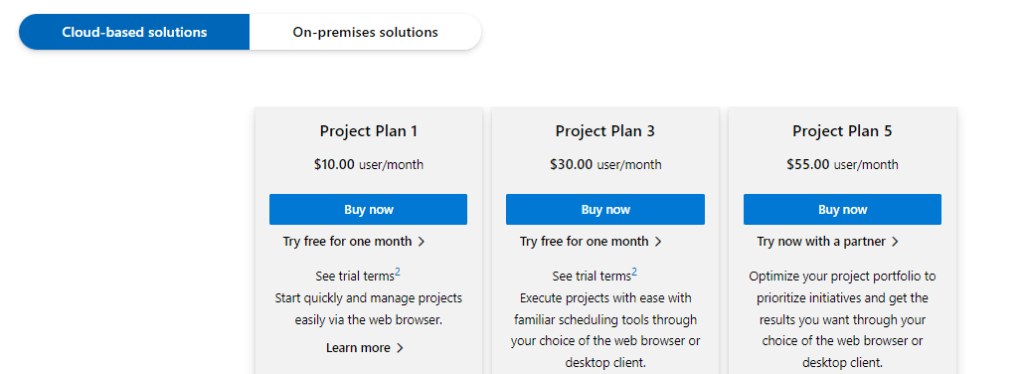Navigating the maze of project management tools can feel a bit like choosing your favorite flavor in an ice cream shop with endless options. You’ve got Zoho Projects on one side, offering a rich tapestry of features with a sprinkle of simplicity, and on the other, Microsoft Project, a powerhouse tool with a legacy as long as the projects it’s designed to manage. The question is, which one will be the cherry on top of your project management sundae?
Zoho Projects | Microsoft Project |
|---|---|
| G2 Score – 4.3 out of 5 stars | G2 Score – 4 out of 5 stars |
| TrustRadius Score – 8.5/10 | TrustRadius Score – 7.6/10 |
Ease of Use and User Interface
Zoho Projects: The Approachable Platform
Imagine walking into a well-lit room where everything is labeled clearly and within reach. That’s Zoho Projects for you. Designed with the user in mind, it strives to make project management as straightforward as possible. The interface is clean, intuitive, and, most importantly, it doesn’t require a manual the size of “War and Peace” to understand. This approachability makes Zoho Projects a hit among teams looking for a solution that doesn’t require a steep learning curve.
Zoho Projects excels in its simplicity without sacrificing functionality. It allows you to jump straight into managing tasks, setting deadlines, and collaborating with your team. The dashboard offers a panoramic view of your project’s health, tasks, milestones, and timesheets, ensuring that key information is just a glance away. Customization options are available to tailor the dashboard and project views to your liking, ensuring that the information most relevant to you is always front and center.
Microsoft Project: The Seasoned Veteran
On the flip side, Microsoft Project feels like entering a command center. It’s robust, sophisticated, and designed for those who speak the intricate language of project management fluently. With its comprehensive set of tools and features, Microsoft Project caters to seasoned project managers looking for depth and detail in their project management software.
The interface of Microsoft Project is packed with features and functionalities that cater to complex project requirements. It offers a plethora of views, from Gantt charts to task boards and everything in between, allowing project managers to dissect their projects from multiple angles. However, this complexity means that new users might find themselves on a steep learning curve, navigating through the myriad of options and features that Microsoft Project offers.
Task Management and Collaboration
Zoho Projects: Simplifying Task Management
Zoho Projects makes task management feel like a breeze. It allows you to create, assign, and track tasks with just a few clicks. The platform supports task dependencies, subtasks, and recurring tasks, ensuring that you can map out your project’s workflow in a way that’s both simple and comprehensive. Each task can be enriched with descriptions, attachments, and custom fields, allowing you to capture all the necessary details in one place.
Collaboration in Zoho Projects is equally user-friendly. The platform includes built-in chat features, forums, and pages where team members can share ideas, updates, and documents. This emphasis on collaboration tools ensures that communication barriers are minimized and that team members have all they need to work together effectively. Additionally, the ability to comment directly on tasks and tag team members keeps conversations relevant and actionable.
Microsoft Project: A Comprehensive Approach
Microsoft Project approaches task management with a level of depth that reflects its enterprise-grade design. It offers detailed task creation capabilities, including extensive options for setting durations, dependencies, and resource allocations. The tool’s strength lies in its ability to manage complex projects, breaking them down into manageable tasks and subtasks, each with detailed schedules and budgets.
Collaboration within Microsoft Project is primarily facilitated through its integration with the broader Microsoft 365 suite, particularly Microsoft Teams. This integration allows team members to communicate and collaborate on project tasks within the familiar Teams environment. However, this approach means that seamless collaboration is somewhat dependent on your team’s adoption of the Microsoft ecosystem.

Related: Check out our free SEO suite

Integration and Extensibility
Zoho Projects: The Integrative Challenger
Zoho Projects doesn’t stand alone; it’s part of the larger Zoho ecosystem, which includes a suite of over 40 applications covering everything from email and document editing to CRM and accounting. This extensive internal integration means that if you’re already using Zoho apps, Zoho Projects will slot into your workflow with ease, providing a unified experience across your business processes.
But Zoho Projects doesn’t limit its connectivity to the Zoho family alone. It boasts a range of integrations with third-party apps, including popular tools like Google Drive, Dropbox, Slack, and GitHub. These integrations are facilitated through direct connections and Zoho’s marketplace, which offers a variety of plugins and extensions. Furthermore, Zoho Projects provides API access, allowing businesses to build custom integrations tailored to their unique needs.
Microsoft Project: The Ecosystem Powerhouse
Microsoft Project’s integration capabilities are deeply rooted in the Microsoft ecosystem, offering seamless connectivity with other Microsoft 365 applications like Excel, SharePoint, and Teams. This integration provides a cohesive experience for users deeply entrenched in the Microsoft world, allowing for effortless data sharing and collaboration across applications.
For projects that require collaboration and communication, Microsoft Project’s integration with Teams is particularly noteworthy. It allows team members to discuss tasks, share files, and update statuses without leaving the Teams environment. Beyond the Microsoft ecosystem, Microsoft Project also supports connections with various third-party tools, though this often requires additional configuration or the use of connectors like those available through Power Automate.
Future-Proofing with Integrations
Diving deeper into the concept of “Future-Proofing with Integrations,” it’s essential to understand the importance of selecting a project management tool that not only meets your immediate needs but also has the capacity to grow and adapt alongside your organization. In the rapidly evolving landscape of digital tools and services, the integrations your project management solution supports today can significantly influence its usefulness and relevance tomorrow.
When we talk about future-proofing with integrations, we’re considering how well a project management tool can keep pace with technological advancements and changes in how we work. It’s about ensuring that your chosen platform can seamlessly connect with new software, tools, and services that your team may adopt in the future. This foresight is crucial for maintaining efficiency, avoiding workflow disruptions, and minimizing the need for cumbersome workarounds as your tech ecosystem expands or shifts.
Zoho Projects:
Zoho Projects positions itself as a forward-thinking choice in this regard by offering a broad spectrum of integrations with both its internal suite of applications and a wide range of third-party tools. Its open API extends this capability further, allowing for custom integrations that can be developed as new needs arise. This approach provides a level of flexibility and adaptability that’s invaluable for businesses in dynamic industries or those that are on a growth trajectory. As new tools emerge or as your business evolves, Zoho Projects is designed to adapt and integrate with these new technologies, ensuring that your project management capabilities remain cutting-edge.
Microsoft Project:
Microsoft Project, on the other hand, anchors its future-proofing strategy in the strength and cohesion of the Microsoft ecosystem. As Microsoft continues to innovate and expand its suite of productivity tools, Microsoft Project is set to benefit from tighter integration and new features that enhance its functionality. For businesses already invested in the Microsoft ecosystem, this means that Microsoft Project will likely continue to offer seamless integration with both existing and future Microsoft technologies. As your team adopts new Microsoft solutions or as Microsoft rolls out new services, Microsoft Project is expected to integrate effortlessly with these advancements, providing a unified and cohesive workflow.
The essence of future-proofing with integrations lies in choosing a project management tool that not only serves your current needs but also has the capacity to grow with your organization. It’s about anticipating the future needs of your team and ensuring that your project management solution can integrate with an ever-changing array of tools and technologies. Whether through Zoho Projects’ flexible and broad integration capabilities or Microsoft Project’s deep integration within the Microsoft ecosystem, the goal is to select a platform that will continue to serve as a vital cog in your organizational machinery, no matter how the landscape of digital tools evolves.
Adaptive Features and Customization
Adaptive features in a project management tool refer to the built-in flexibility that allows the software to cater to various project types, sizes, and complexities. This could mean offering different project views, such as Gantt charts for those who prefer a visual representation of timelines or Kanban boards for teams that operate on agile methodologies. It also includes the ability to customize workflows, task fields, and reports to match the specific requirements of a project or team. The more a tool can adapt to the unique workflows and processes of its users, the more effectively those users can manage their projects without having to adjust their working styles to fit the constraints of the software.
Customization plays a crucial role here as well. It’s about allowing teams to modify the tool to fit their specific needs, whether that’s by adding custom fields to capture unique project data, tailoring notification settings to reduce noise, or creating templates that streamline project setup. Customization can extend to the user interface itself, enabling teams to create a workspace that is intuitively organized and prioritizes the information most relevant to their needs. When a project management tool offers a high degree of customization, it empowers teams to craft a solution that feels like it was made just for them, enhancing user adoption and satisfaction.
Zoho Projects:
Zoho Projects and Microsoft Project approach adaptive features and customization in ways that reflect their underlying philosophies and target audiences. Zoho Projects, with its emphasis on flexibility and user-friendliness, offers a variety of options for tailoring the platform to fit the specific needs of a team or project. It provides a wide array of customizable templates, fields, and workflows, aiming to accommodate a broad spectrum of project types and management styles. This makes Zoho Projects an attractive option for teams looking for a tool that can easily adapt to their evolving needs without requiring extensive technical know-how.
Microsoft Project:
Microsoft Project, known for its robust set of features designed to meet the demands of complex projects, also offers significant customization capabilities. However, its approach tends to cater more towards project management professionals who require detailed control over every aspect of their project planning and execution. Microsoft Project allows for intricate customization of schedules, resources, and reports, offering a level of detail that can be invaluable for large, complex projects. This depth of customization, while powerful, may come with a steeper learning curve, making it more suitable for teams with dedicated project management expertise.
Pricing
Zoho Projects:

Microsoft Project:

Conclusion
Choosing the right project management tool is a critical decision that can significantly impact your team’s productivity and project outcomes. Both Zoho Projects and Microsoft Project offer unique advantages that cater to different needs and preferences. By carefully considering your team’s specific requirements and evaluating each tool’s offerings, you can select a solution that not only meets your current needs but also positions your team for future success.
Whether you choose Zoho Projects for its flexibility and user-centric design or Microsoft Project for its comprehensive features and Microsoft ecosystem integration, the most important factor is how well the tool supports your team in achieving its project goals. With the right project management solution, you can streamline workflows, enhance collaboration, and drive your projects to successful completion.
Read Next:
- Agorapulse vs Friends+Me: The Best Social Media Management Tool for You
- SocialBee vs Later: The Best Social Media Management Tool for You
- Campaign Monitor vs Iterable: The Best Email Marketing Tool
- ConvertKit vs iContact: The Best Email Marketing Tool for 2024
- ConvertKit vs Automizy: The Best Email Marketing Tool for 2024






















Comments are closed.